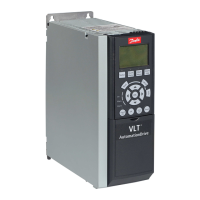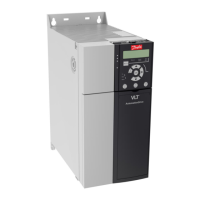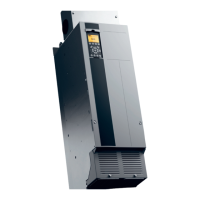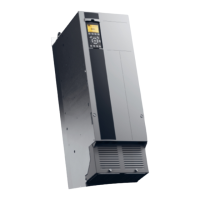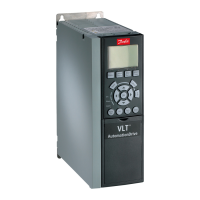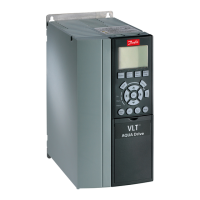3-40 Ramp 1 Type
Option: Function:
A linear ramp will give constant acceleration
during ramping. An S-ramp will give non-
linear acceleration, compensating for jerk in
the application.
[0] * Linear
[1] S-ramp
Const Jerk
Acceleration with lowest possible jerk.
[2] S-ramp
Const Time
S-ramp based on the values set in 3-41 Ramp
1 Ramp up Time and 3-42 Ramp 1 Ramp Down
Time.
NOTE
If [1] S-ramp Const Jerk is selected and the reference during
ramping is changed the ramp time may be prolonged in
order to realize a jerk free movement which may result in
a longer start or stop time.
Additional adjustment of the S-ramp ratios or switching
initiators may be necessary.
3-41 Ramp 1 Ramp up Time
Range: Function:
Size
related*
[ 0.01 -
3600.00
s]
Enter the ramp-up time, i.e. the
acceleration time from 0 RPM to the
synchronous motor speed n
S
. Choose a
ramp-up time such that the output current
does not exceed the current limit in
4-18 Current Limit during ramping. The
value 0.00 corresponds to 0.01 s in speed
mode. See ramp-down time in 3-42 Ramp 1
Ramp Down Time.
Par
. 3 − 41 =
t
acc
s
x
n
s
RPM
ref
RPM
3-42 Ramp 1 Ramp Down Time
Range: Function:
Size
related*
[ 0.01 -
3600.00
s]
Enter the ramp-down time, that is, the
deceleration time from the synchronous
motor speed n
s
to 0 RPM. Choose a ramp-
down time such that no over-voltage arises
in the inverter due to regenerative
operation of the motor, and such that the
generated current does not exceed the
current limit set in 4-18 Current Limit. The
value 0.00 corresponds to 0.01 s in speed
mode. See ramp-up time in 3-41 Ramp 1
Ramp up Time.
Par
. 3 − 42 =
t
dec
s
x
n
s
RPM
ref
RPM
3-45 Ramp 1 S-ramp Ratio at Accel. Start
Range: Function:
50 %* [ 1 - 99.
%]
Enter the proportion of the total ramp-up
time (3-41 Ramp 1 Ramp up Time) in which
3-45 Ramp 1 S-ramp Ratio at Accel. Start
Range: Function:
the acceleration torque increases. The larger
the percentage value, the greater the jerk
compensation achieved, and thus the lower
the torque jerks occurring in the application.
3-46 Ramp 1 S-ramp Ratio at Accel. End
Range: Function:
50 %* [ 1 - 99.
%]
Enter the proportion of the total ramp-up
time (3-41 Ramp 1 Ramp up Time) in which
the acceleration torque decreases. The larger
the percentage value, the greater the jerk
compensation achieved, and thus the lower
the torque jerks in the application.
3-47 Ramp 1 S-ramp Ratio at Decel. Start
Range: Function:
50 %* [ 1 - 99.
%]
Enter the proportion of the total ramp-down
time (3-42 Ramp 1 Ramp Down Time) where
the deceleration torque increases. The larger
the percentage value, the greater the jerk
compensation achieved, and thus the lower
the torque jerks in the application.
3-48 Ramp 1 S-ramp Ratio at Decel. End
Range: Function:
50 %* [ 1 - 99.
%]
Enter the proportion of the total ramp-down
time (3-42 Ramp 1 Ramp Down Time) where
the deceleration torque decreases. The
larger the percentage value, the greater the
jerk compensation achieved, and thus the
lower the torque jerks in the application.
3.5.4 3-5* Ramp 2
Choosing ramp parameters, see parameter group 3-4*.
3-50 Ramp 2 Type
Option: Function:
Select the ramp type, depending on
requirements for acceleration/deceleration. A
linear ramp will give constant acceleration
during ramping. An S-ramp will give non-
linear acceleration, compensating for jerk in
the application.
[0] * Linear
[1] S-ramp
Const Jerk
Acceleration with lowest possible jerk
[2] S-ramp
Const Time
S-ramp based on the values set in 3-51 Ramp
2 Ramp up Time and 3-52 Ramp 2 Ramp down
Time
Parameter Descriptions
VLT
®
AutomationDrive Programmming Guide
60 MG33ME02 - VLT
®
is a registered Danfoss trademark
3
3

